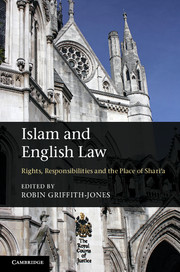Book contents
- Frontmatter
- Contents
- List of contributors
- List of abbreviations
- Preface
- Introduction
- Part I The Archbishop of Canterbury and shariʽa law
- Part II The Archbishop’s proposal for ‘transformative accommodation’
- Part III Responsibilities and rights
- Freedom of speech, incitement to religious hatred: beyond the divide?
- 13 Where to draw the line, and how to draw it
- 14 Censor or censure: maintaining civility
- 15 In praise of ‘fuzzy law’
- Religion, the state and the meaning of ‘jihad’
- Part IV Prospect: equality before God and before the law
- Select bibliography
- Index of cases
- Index
13 - Where to draw the line, and how to draw it
Published online by Cambridge University Press: 05 April 2013
- Frontmatter
- Contents
- List of contributors
- List of abbreviations
- Preface
- Introduction
- Part I The Archbishop of Canterbury and shariʽa law
- Part II The Archbishop’s proposal for ‘transformative accommodation’
- Part III Responsibilities and rights
- Freedom of speech, incitement to religious hatred: beyond the divide?
- 13 Where to draw the line, and how to draw it
- 14 Censor or censure: maintaining civility
- 15 In praise of ‘fuzzy law’
- Religion, the state and the meaning of ‘jihad’
- Part IV Prospect: equality before God and before the law
- Select bibliography
- Index of cases
- Index
Summary
The discussion which follows between Tariq Modood and Albie Sachs raises fundamental questions about the right to freedom of speech. Their chapters are based on their debate at the Temple Church, which focused on (but was by no means limited to) the controversies which arose from Salman Rushdie’s novel, The Satanic Verses, and from the publication in a Danish newspaper of cartoons satirising or mocking the Prophet and Islam generally. The novel and the cartoon undoubtedly caused grave offence to members of the Muslim faith. To what extent should law protect statements which are offensive to a not insubstantial section of the public? In particular should there be any limitation on speech or writing offensive to deeply held religious feelings? Does literary merit redeem a grossly offensive and insulting publication?
In the UK freedom of expression is not an absolute right. It must be balanced against other rights and such interests as national security and public safety. But in general freedom of speech in the UK encompasses the freedom to give offence to others, whether individuals or groups. Indeed, it has been said that at the heart of freedom of speech is the freedom to offend.
- Type
- Chapter
- Information
- Islam and English LawRights, Responsibilities and the Place of Shari'a, pp. 208 - 215Publisher: Cambridge University PressPrint publication year: 2013



